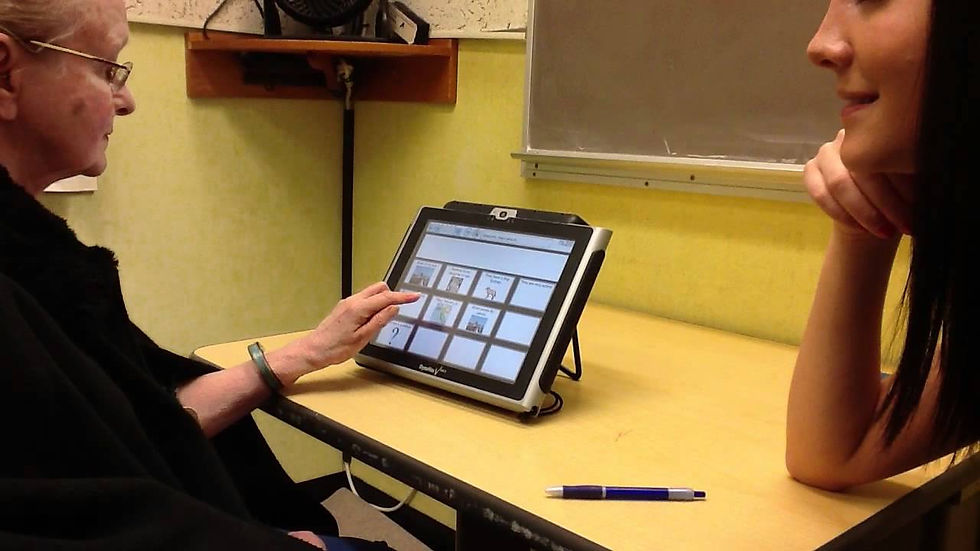Technology for Communication: The Magic of Augmentative and Alternative Communication Devices
- Rebecca Kruise
- Aug 1, 2024
- 3 min read

Augmentative and Alternative Communication devices (AAC) are valuable tools for individuals with communication challenges. Whether someone is born with a condition, like cerebral palsy or autism or acquires a condition later, like Parkinson’s, stroke, or multiple sclerosis, AAC devices can provide a solution for communication and connection.
These devices are versatile, adaptable, and can be used by individuals of all ages. The devices can supplement existing speech, be an alternative when speech is absent, or be a temporary option for those in intensive care or recovering from an acute event.
In this blog post, we’ll explore the benefits and applications of AAC devices. We will consider their significance in enhancing the quality of life for those with communication difficulties.
Types of AAC Devices
There are two main types of AAC: aided and unaided. Unaided communication does not require any additional materials or devices. It includes communication through body language, facial expressions, finger spelling, and sign language.
Aided communication is communication that is facilitated with an additional tool or device. Aided communication can be a low-tech device such as a communication book or board with several images to select from and/or simply a notebook for the individual to write or draw images to communicate their thoughts, feelings, and needs. With advancing technology, there are several options for high-tech devices, such as computers, tablets, and smartphones. These devices can have apps for individuals to type, write, or draw to communicate with those around them. There are also speech-generating devices (SGDs) that produce words, phrases, and sentences based on the user's preferences.
Speech-Generating Devices
These SGDs have a wide variety of options, including different voice output options that can be modified to resemble the user's voice in age, ethnicity, gender, language, race, and rate of speech. Newer devices have options that include the ability to voice bank or message bank for individuals who will likely lose their ability to communicate verbally.
Voice banking and message banking are completed before losing the ability to communicate verbally. Voice Banking is a process where an individual records specific phrases and sentences that are then used to create a personalized synthetic voice. These phrases are then processed by software to create a personal voice through extracting speech patterns, tones, and other vocal characteristics. Once Voice banking is completed, the user can use the device to communicate anything they want in their own voice. However, this may sound robotic as the user is not directly saying the words, phrases, and sentences themselves.
On the other hand, message banking is where the user records various words, phrases, and sentences that are then loaded into a device and can be played at any time in their own speech. The downside of message banking is that new phrases can not be generated; only the phrases that were pre-recorded can be generated in that individual's voice.

The Role of the Speech Language Pathologist
Speech language pathologists are experts in communication and are highly trained in helping people find and use their voices and other methods to communicate with those around them. An SLP is a critical component in accessing AAC devices. Here’s how they can help:
Assessing the need for an AAC device
Determining what type of device would be most beneficial
Creating/obtaining the device
Training the patient and family on using the device
Collaborating with the AAC manufacturer (if a high-tech device is recommended)
Educating staff members on how to use the device with the client
Maintaining and modifying the device as needed
The versatility and effectiveness of Augmentative and Alternative Communication (AAC) devices in facilitating communication for individuals with speech challenges cannot be overstated. The range of AAC tools available today is remarkable, from simple, low-tech options like communication books to advanced speech-generating devices with personalized voice output. The crucial role of speech language pathologists in assessing needs, selecting appropriate devices, and providing ongoing support underscores the importance of a comprehensive approach to AAC implementation. By embracing AAC technologies and the expertise of professionals, individuals can overcome communication barriers and experience a profound improvement in their quality of life.






